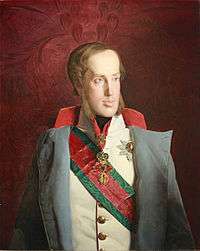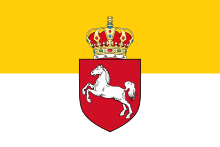Archduke Franz Karl of Austria
Archduke Franz Karl Joseph of Austria (17 December 1802 – 8 March 1878) was a member of the House of Habsburg-Lorraine. He was the father of two emperors: Franz Joseph I of Austria and Maximilian I of Mexico. Through his third son Karl Ludwig, he was the grandfather of Archduke Franz Ferdinand of Austria – whose assassination sparked the hostilities that led to the outbreak of World War I – and the great-grandfather of the last Habsburg emperor Karl I.
| Archduke Franz Karl | |||||
|---|---|---|---|---|---|
Franz Karl at age 75, 1878. | |||||
| Born | 17 December 1802 Vienna, Austria | ||||
| Died | 8 March 1878 (aged 75) Vienna, Austria-Hungary | ||||
| Burial | |||||
| Spouse | Princess Sophie of Bavaria | ||||
| Issue | Franz Joseph I of Austria Maximilian I of Mexico Archduke Karl Ludwig Archduchess Maria Anna Archduke Ludwig Viktor | ||||
| |||||
| House | Habsburg-Lorraine | ||||
| Father | Francis II, Holy Roman Emperor | ||||
| Mother | Princess Maria Theresa of Naples and Sicily | ||||
| Religion | Roman Catholicism | ||||
| Styles of Archduke Franz Carl of Austria | |
|---|---|
.svg.png) | |
| Reference style | His Imperial and Royal Highness |
| Spoken style | Your Imperial and Royal Highness |
Life
Early life and marriage

Franz Karl was born in Vienna, the third son of Emperor Francis II (I) by his second marriage with Princess Maria Theresa from the House of Bourbon, daughter of King Ferdinand I of the Two Sicilies and Maria Carolina of Habsburg-Lorraine. On 4 November 1824 in Vienna he married Princess Sophie of Bavaria from the House of Wittelsbach, a daughter of King Maximilian I Joseph of Bavaria by his second wife Caroline of Baden. Sophie's paternal half-sister, Caroline Augusta of Bavaria was by this time Franz Karl's stepmother, having married his thrice-widowed father in 1816. The Wittelsbachs condoned the unappealing manners of Sophie's husband in consideration of the incapability of his elder brother Ferdinand and Sophie's chance to become Austrian Empress.
Franz Karl was an unambitious and generally ineffectual man, although he was, together with his uncle Archduke Louis a member of the Geheime Staatskonferenz council, which after the death of Emperor Francis II ruled the Austrian Empire in the stead of his mentally ill brother Ferdinand from 1835 to 1848. The decisions, however, were actually made by the Minister of State Prince Klemens Wenzel von Metternich and his rival Count Franz Anton von Kolowrat-Liebsteinsky. His wife Sophie had already transferred her ambitions, when she urged Franz Karl to renounce his claims to the throne at the time of his brother's abdication on 2 December 1848, allowing their eldest son Franz Joseph I to take the throne.
Death and burial
Archduke Franz Karl died in Vienna in 1878, six years after the death of his wife. He is buried at the Imperial Crypt at the Capuchin Church. Franz Karl was the last Habsburg whose viscera were entombed at the Ducal Crypt of St. Stephen's Cathedral and whose heart was placed at the Herzgruft of the Augustinian Church according to a centuries-long family rite.
Honours and awards
He received the following awards:[1]

- Knight of the Golden Fleece, 1817[2]
- Grand Cross of St. Stephen, 1835[3]

.svg.png)

.svg.png)
- Knight of the Black Eagle, 9 September 1835[7]
- Knight of the Red Eagle, 1st Class
.svg.png)
- Grand Cross of the House Order of Fidelity, 1835
- Grand Cross of the Zähringer Lion, 1835

- Knight of St. Andrew, 1835
- Knight of St. Alexander Nevsky, 1835
- Knight of the White Eagle, 1835
- Knight of St. Anna, 1st Class, 1835


- Grand Cross of the Royal Guelphic Order, 1839
- Knight of St. George, 1847

.svg.png)

.svg.png)

.svg.png)
.svg.png)
.svg.png)
.svg.png)

.svg.png)
.svg.png)
.svg.png)
Issue
| Name | Birth | Death | Notes |
|---|---|---|---|
| By Sophie, Princess of Bavaria (27 January 1805 – 28 May 1872; married on 4 November 1824 in St. Augustine's Church, Vienna) | |||
| Franz Joseph | 18 August 1830 | 21 November 1916 | Succeeded as Emperor of Austria; married his first cousin Elisabeth, Duchess in Bavaria, and had issue |
| Maximilian | 6 July 1832 | 19 June 1867 | Proclaimed Emperor of Mexico executed by a firing squad married Charlotte, Princess of Belgium, no issue |
| Karl Ludwig | 30 July 1833 | 19 May 1896 | Married 1) his first cousin Margaretha, Princess of and Duchess in Saxony, (1840–1858) from 1856 to 1858, no issue, married 2) to Maria Annunziata, Princess of the Two-Sicilies (1843–1871) from 1862 to 1871, had issue (three sons and one daughter) and married 3) to Maria Theresia, Infanta of Portugal, (1855–1944), from 1873 to 1899, had issue (two daughters) |
| Maria Anna | 27 October 1835 | 5 February 1840 | Died in childhood, no issue |
| Stillborn son | 24 October 1840 | 24 October 1840 | |
| Ludwig Viktor | 15 May 1842 | 18 January 1919 | Died unmarried, no issue |
See also
Ancestors
| Ancestors of Archduke Franz Karl of Austria | |||||||||||||||||||||||||||||||||||||||||||||||||||||||||||||||||||||||||||||||||||||||||||||||||||||||||||||||||||||||||||||||||||||||||||||||||||||||||||||||||||||||||||||||||||||||||||||||||||||||||||||||||||||||||||||||||||||||||||||||||||||||||||||||||||||||||||||||||||||||||
|---|---|---|---|---|---|---|---|---|---|---|---|---|---|---|---|---|---|---|---|---|---|---|---|---|---|---|---|---|---|---|---|---|---|---|---|---|---|---|---|---|---|---|---|---|---|---|---|---|---|---|---|---|---|---|---|---|---|---|---|---|---|---|---|---|---|---|---|---|---|---|---|---|---|---|---|---|---|---|---|---|---|---|---|---|---|---|---|---|---|---|---|---|---|---|---|---|---|---|---|---|---|---|---|---|---|---|---|---|---|---|---|---|---|---|---|---|---|---|---|---|---|---|---|---|---|---|---|---|---|---|---|---|---|---|---|---|---|---|---|---|---|---|---|---|---|---|---|---|---|---|---|---|---|---|---|---|---|---|---|---|---|---|---|---|---|---|---|---|---|---|---|---|---|---|---|---|---|---|---|---|---|---|---|---|---|---|---|---|---|---|---|---|---|---|---|---|---|---|---|---|---|---|---|---|---|---|---|---|---|---|---|---|---|---|---|---|---|---|---|---|---|---|---|---|---|---|---|---|---|---|---|---|---|---|---|---|---|---|---|---|---|---|---|---|---|---|---|---|---|---|---|---|---|---|---|---|---|---|---|---|---|---|---|---|---|---|---|---|---|---|---|---|---|---|---|---|---|---|---|---|---|
| |||||||||||||||||||||||||||||||||||||||||||||||||||||||||||||||||||||||||||||||||||||||||||||||||||||||||||||||||||||||||||||||||||||||||||||||||||||||||||||||||||||||||||||||||||||||||||||||||||||||||||||||||||||||||||||||||||||||||||||||||||||||||||||||||||||||||||||||||||||||||
References
- Hof- und Staats-Handbuch des Kaiserthumes Österreich (1878), Genealogy p. 5
- Boettger, T. F. "Chevaliers de la Toisón d'Or - Knights of the Golden Fleece". La Confrérie Amicale. Retrieved 25 June 2019.
- "A Szent István Rend tagjai" Archived 22 December 2010 at the Wayback Machine
- Teulet, Alexandre (1863). "Liste chronologique des chevaliers de l'ordre du Saint-Esprit depuis son origine jusqu'à son extinction (1578-1830)" [Chronological List of Knights of the Order of the Holy Spirit from its origin to its extinction (1578-1830)]. Annuaire-bulletin de la Société de l'histoire de France (in French) (2): 117. Retrieved 24 March 2020.
- Hof- und Staats-Handbuch des Königreichs Bayern (in German). Königl. Oberpostamt. 1867. p. 8. Retrieved 2019-07-15.
- Almanacco di corte (in Italian). 1858. Retrieved 2019-04-24.
- Liste der Ritter des Königlich Preußischen Hohen Ordens vom Schwarzen Adler (1851), "Von Seiner Majestät dem Könige Friedrich Wilhelm III. ernannte Ritter" p. 20
- Hof- und Staats-Handbuch des Großherzogtum Baden (1836), "Großherzogliche Orden" pp. 27, 42
- Sergey Semenovich Levin (2003). "Lists of Knights and Ladies". Order of the Holy Apostle Andrew the First-called (1699-1917). Order of the Holy Great Martyr Catherine (1714-1917). Moscow.
- Hof- und Staats-Handbuch des Großherzogtum Hessen (1869), "Großherzogliche Orden und Ehrenzeichen" p. 8
- Hof- und Staats-Handbuch des Königreich Hannover (1865), "Königliche Orden und Ehrenzeichen" pp. 38, 75
- Hof- und Staats-Handbuch des Königreich Württemberg (1866), "Königliche Orden" p. 30
- Sveriges statskalender (in Swedish), 1877, p. 368, retrieved 2018-01-06 – via runeberg.org
- Staatshandbuch für den Freistaat Sachsen (1867) (in German), "Königliche Ritter-Orden", p. 4
- Hof- und Staatshandbuch des Großherzogtums Oldenburg: für das Jahr 1872/73, "Der Großherzogliche Haus-und Verdienst Orden" p. 30
- Staatshandbücher für das Herzogtum Sachsen-Coburg und Gotha (1865), "Herzogliche Sachsen-Ernestinischer Hausorden" p. 20
- Wurzbach, Constantin, von, ed. (1861). . Biographisches Lexikon des Kaiserthums Oesterreich [Biographical Encyclopedia of the Austrian Empire] (in German). 7. p. 60 – via Wikisource.
- Wurzbach, Constantin, von, ed. (1860). . Biographisches Lexikon des Kaiserthums Oesterreich [Biographical Encyclopedia of the Austrian Empire] (in German). 6. p. 208 – via Wikisource.
- Wurzbach, Constantin, von, ed. (1861). . Biographisches Lexikon des Kaiserthums Oesterreich [Biographical Encyclopedia of the Austrian Empire] (in German). 7. p. 53 – via Wikisource.
- Genealogie ascendante jusqu'au quatrieme degre inclusivement de tous les Rois et Princes de maisons souveraines de l'Europe actuellement vivans [Genealogy up to the fourth degree inclusive of all the Kings and Princes of sovereign houses of Europe currently living] (in French). Bourdeaux: Frederic Guillaume Birnstiel. 1768. p. 9.
- Wurzbach, Constantin, von, ed. (1861). . Biographisches Lexikon des Kaiserthums Oesterreich [Biographical Encyclopedia of the Austrian Empire] (in German). 7. p. 81 – via Wikisource.
External links
![]()